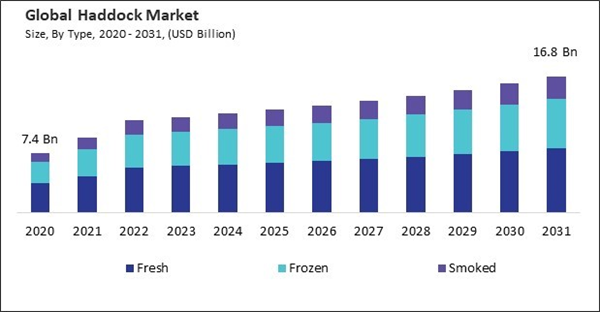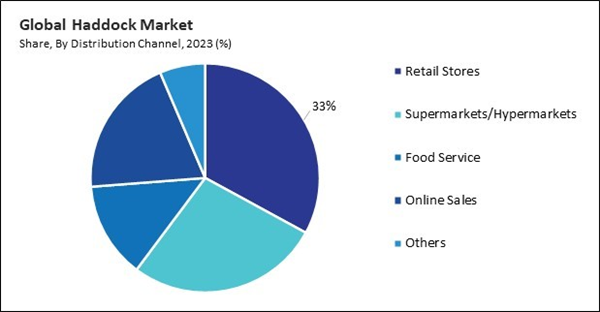Europe has a strong tradition of seafood consumption. Countries such as the United Kingdom, Norway, and Iceland have diets that are significantly reliant on fish, with haddock being particularly popular. European countries have well-established fishing industries. Thus, the Europe region acquired 47.8% revenue share in the market 2023. In terms of volume the Europe region is expected to attain a volume of 3,33,119.20 tonnes of haddock by 2031. The North Sea is one of the most significant sources of haddock, supporting local supply chains and ensuring fresh product availability. Europe could strengthen its market position by continuing to lead in sustainable fishing and traceability initiatives, which are increasingly important to consumers.
As populations become more health-conscious, many are turning away from red and processed meats, which have been linked to various health issues, including heart disease and certain types of cancer. Seafood, rich in essential nutrients and typically lower in fats, presents a favorable alternative.
Additionally, because of the globalization of food culture, the global food industry has become more interconnected and diverse, substantially influencing eating habits and culinary preferences on a global scale. Therefore, the globalization of food trends is aiding the growing demand for it.
However, overfishing has severe repercussions for the market, affecting both the ecological health of marine environments and the economic stability of the seafood industry. The detrimental effects are broad, creating a chain of challenges that could jeopardize the sustainability and profitability of haddock fisheries for years to come.
Driving and Restraining Factors
Drivers- Growing demand for seafood across the world
- Expansion of the aquaculture industry worldwide
- Rapid globalization of food trends
- Overfishing and sustainability concerns
- Consumer preferences and competition
- Rising use of sustainable fishing practices
- Improvements in supply chain and logistics
- Regulatory and policy challenges
- Substantial supply chain inefficiencies
Distribution Channel Outlook
On the basis of distribution channel, the market is classified into retail stores, food service, supermarkets/hypermarkets, online sales, and others. The retail stores segment acquired 32.9% revenue share in the market in 2023. Thus, the retail stores segment would attain a volume of 2,14,900.20 tonnes by 2031. Retail stores are typically more accessible to the average consumer, providing easy access to fresh, frozen, and smoked haddock.Type Outlook
Based on type, the market is characterized into fresh, frozen, and smoked. The frozen segment procured 35.6% revenue share in the market in 2023. IN the terms of volume Frozen segment would attain a volume of 3,24,469.94 tonnes by 2031. haddock's significant position is driven by its longer shelf life and convenience, appealing to consumers who may not have immediate access to fresh seafood.Regional Outlook
Region-wise, the market is analyzed across North America, Europe, Asia Pacific, and LAMEA. The Asia Pacific segment garnered 24.6% revenue share in the market in 2023. In terms of volume the Asia Pacific region is expected to attain a volume of 1,99,609.82 tonnes by 2031. The demand for a variety of high-quality protein sources, such as seafood or haddock, is on the rise in many countries due to the growing middle class.List of Key Companies Profiled
- Ocean More Foods Co., Limited
- Channel Fish Processing
- Channel Seafoods International, LLC
- CTLE Seafood, Inc.
- Holmes Seafood Ltd. (Brasmar)
- Hottlet Frozen Foods N.V.
- Marz Seafood
- Seacore Seafood Inc.
- Polar Seafood Greenland A/S
- The Fish Company ltd.
Market Report Segmentation
By Type (Volume, Tonnes, USD Billion, 2020-2031)- Fresh
- Frozen
- Smoked
- Retail Stores
- Supermarkets/Hypermarkets
- Food Service
- Online Sales
- Others
- North America
- US
- Canada
- Mexico
- Rest of North America
- Europe
- Germany
- UK
- France
- Russia
- Spain
- Italy
- Rest of Europe
- Asia Pacific
- China
- Japan
- India
- South Korea
- Singapore
- Malaysia
- Rest of Asia Pacific
- LAMEA
- Brazil
- Argentina
- UAE
- Saudi Arabia
- South Africa
- Nigeria
- Rest of LAMEA
Table of Contents
Companies Mentioned
- Ocean More Foods Co., Limited
- Channel Fish Processing
- Channel Seafoods International, LLC
- CTLE Seafood, Inc.
- Holmes Seafood Ltd. (Brasmar)
- Hottlet Frozen Foods N.V.
- Marz Seafood
- Seacore Seafood Inc.
- Polar Seafood Greenland A/S
- The Fish Company ltd.
Methodology

LOADING...










